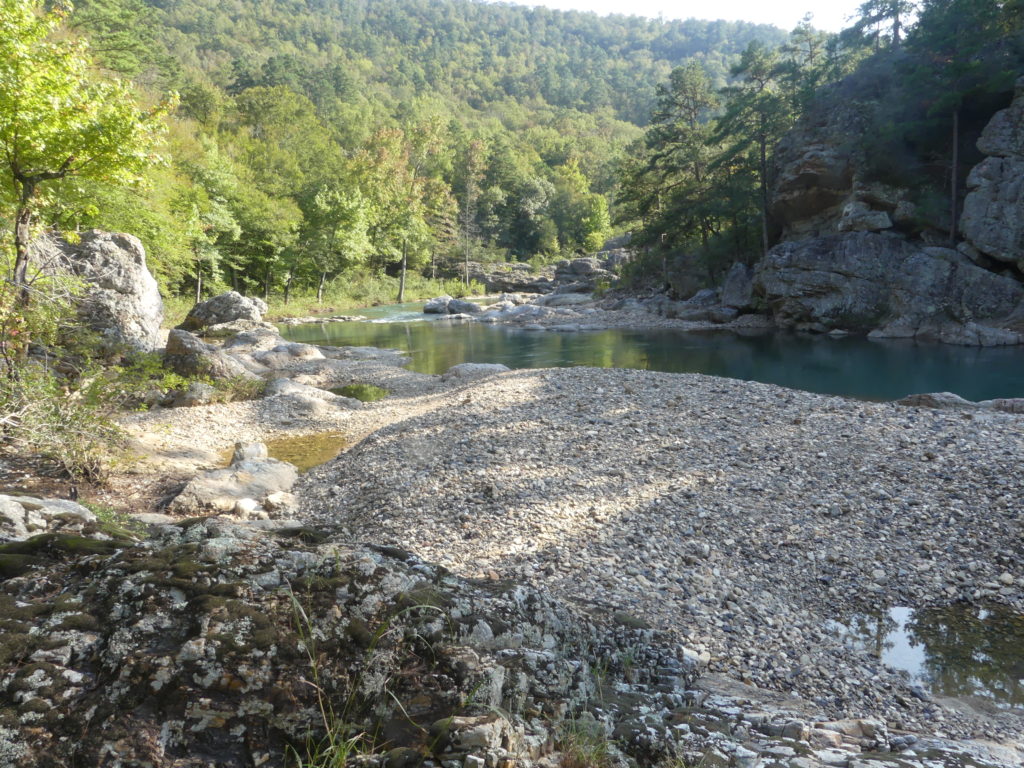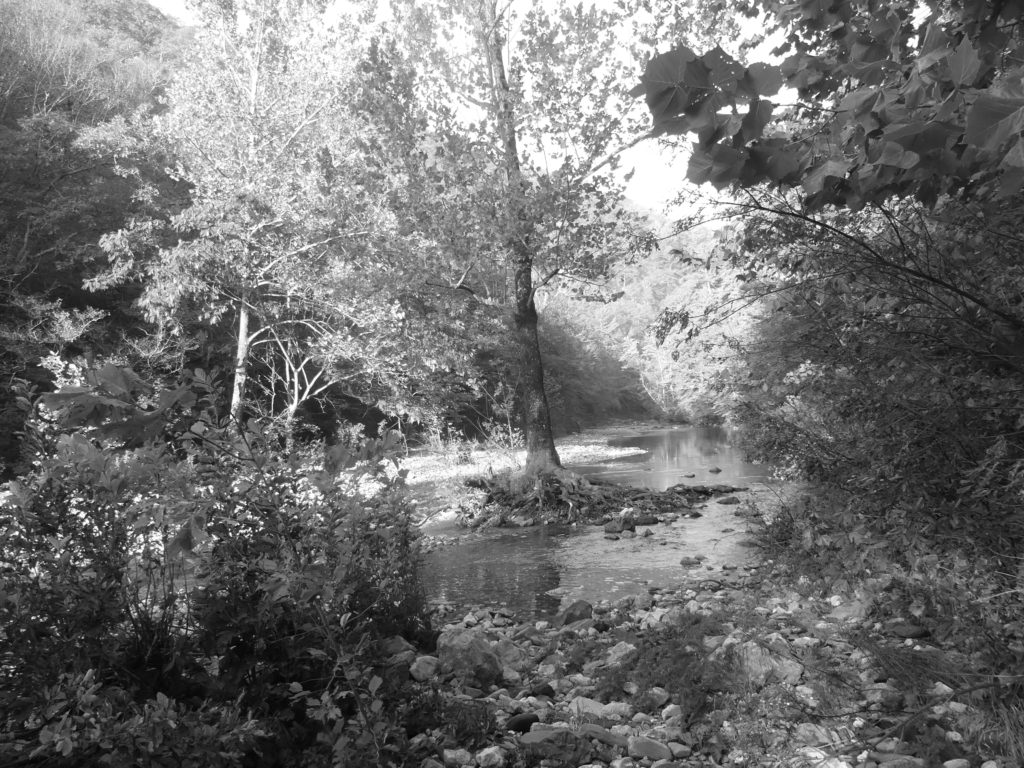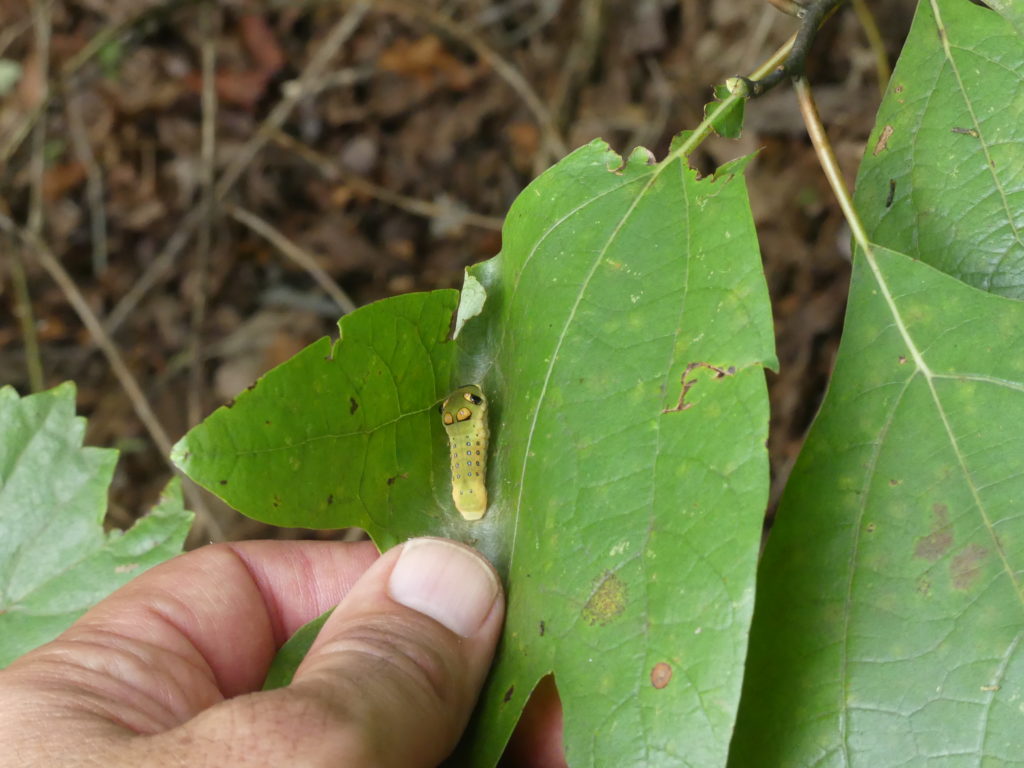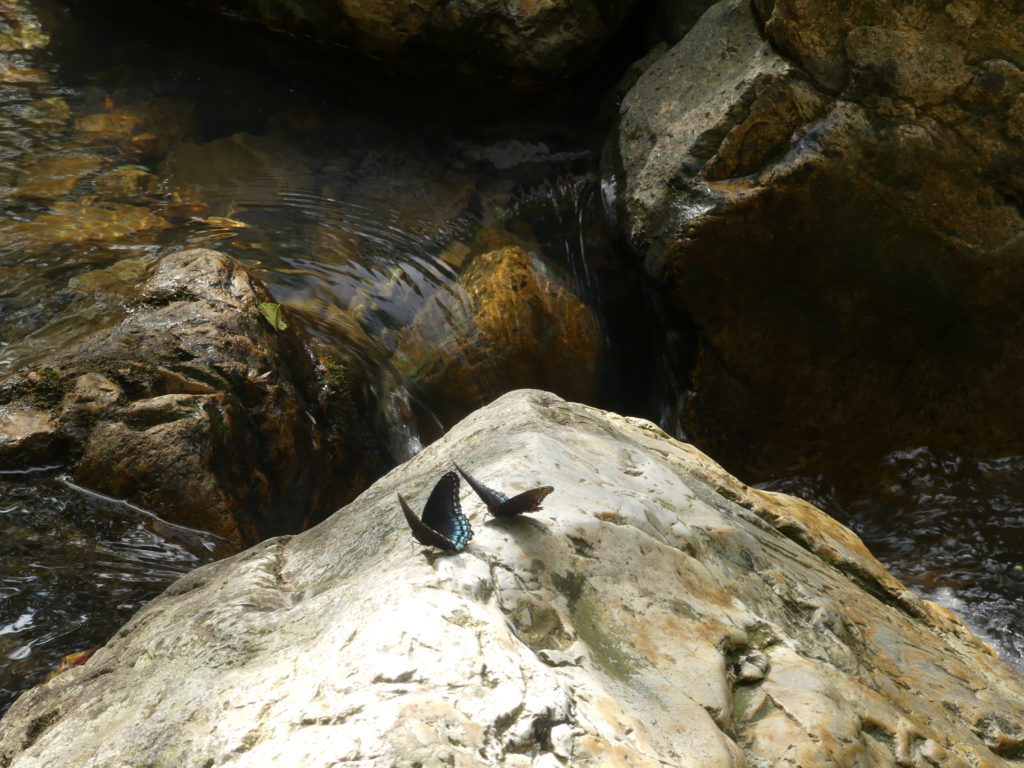Time Passages, reflections on a solo hike on the Eagle Rock Loop, Ouachita National Forest, Arkansas

“all around, the day was going down slow. Night, like a river, beginning to flow. I felt the beat of my mind go, drifting, into time passages.”- Al Stewart 1978
300 million years ago, give or take a few million, tectonic plates pushed together, buckling thick layers of sediment deposited during preceding millenia in ancient seas in an area now part of north central Arkansas. This began a process of mountain building and mountain unbuilding. Today, these ridges make up the Ouachita Mountain range. During the Labor Day weekend in 2019, a friend and I hiked the Eagle Rock Loop (ERL), a 26.8-mile trail that fords several streams including the Little Missouri River and climbs a half dozen steep ridges with a net gain of 4000 feet. I vowed to return to the area as too many secrets lay hidden its deep forests, amongst the mosaic of stones scattered like jig saw pieces on the trail and creek banks and lurking within the ethereal soundscape of the rushing waters.
What is it about places that have a complex geological history that draw us? Over vast swaths of time, relentless forces have left us monuments of stone with a unique assortment of lifeforms adapted to every nook, cranny and crevasse. Succumbing to the pull of gravity, slipping fault lines, wind blasts, and the multi-pronged attacks of fickle water both providing life giving sustenance and acting as a relentless chisel, these crags stand as time tested testimonials of endurance.
On Friday September 25, 2020, Year of The COVID 19 Pandemic, at approximately 7 a.m. I departed The Colony and headed toward Arkansas once again. I had spun around the sun one more time, and was now entering the 60th autumn of my life. My “long weekend” trip, made possible by strategically allocating 7.5 hours of PTO (personal time off) would account for 56 hours of my life. I was on a tight agenda to live in the moment!
It is important to have goals:
- Return to ERL and complete the loop again.
- Hike solo (much to the trepidation of Laurie, my wife).
- Catch a smallmouth on the Little Missouri River on a fly.
- Solve the mystery of the mostly hidden flora and fauna of the Ouachita National Forest and hopefully see more of it on this visit.
- Commune with the trees again. Those majestic giants.
- Cool off and skinny dip in a cold mountain stream again.
- Avoid injury (see #2), falling in a creek and all unforeseen disasters.
- Stay dry (lots of wet crossings) and sleep well and warm in a tent for 2 nights.
- Avoid hunger and dehydration.
- Gawk at all of those beautiful rocks.
- Escape the constant media feed of current event mayhem.
- Be one with the Universe (Is that too much to ask?)
I am happy to report that many of these goals were met.
The weather was perfect, not too hot or cold and no rain. I did complete the ERL in approximately 15.5 hours of walking, 10 ½ hours on Saturday alone, a day with steep 6 ridge climbs. I did fall and bash open my right knee on an innocent small creek crossing an hour into Saturday’s hike, but thankfully, no derangement of ligaments occurred! (Trail Wisdom: When a stream crossing involves more than 3 steps, it is likely you will lose concentration and fall. Even if you step on the rock you have selected, there is no guarantee it’s not as slick as black ice. Either step in the water or take the time to switch into your water sandals).
Since I went as a Naturalist seeking a closer glimpse of the endemic species of the area and this audience is likely interested in such matters, I will briefly summarize what I observed.
Flora:

The most prominent features of the area along the ERL are the endless stands of trees, some of which must be 50 to 100 years old or likely older. Roots snake like boa constrictors over rocks and down steep, mossy slopes, resulting in uneven footing on the rocky trails. A dominant tree is the Beech with a distinct patina of subtle patches of lichens, living beauty spots. Other key species are pines, oaks, both red and white varieties, hickory, sweet gum, and holly. One memorable tree, was a majestic sycamore, perhaps 30 years old and over 60 feet tall, observed with a tangled mass of exposed roots anchored to a small rocky island in the Little Missouri River itself. How it had managed to survive the relentless periodic flooding is beyond me.
Because the forest exudes moisture and the creeks volatilize moisture in the air, lichens, mosses and ferns abound, providing a soothing carpet of green. Close inspection of this lush landscape reveals a complex world within a world as the lichens, themselves symbiotic biospheres (as I learned over the weekend during the TXMN virtual convention), mosses and ferns provide micro habitats for all sorts of life forms. The fungi were abundant, more so than I remember from my last visit. All colors, shapes and sizes were seen. Scalloped shelf fungi, hiking boot tall white mushrooms with a 10-inch diameter top disk, clusters of yellow domes, 2 pink, slobbery gumballs on the side of a tree, a pale blue capped mushroom that seemed to glow in the misty dawn, orange pustules puffing spores on a pine stripped of protective bark and countless others poked out of the loam and leaf litter.
Fauna:
On my last visit to the ERL the key animal sighting was a bobcat my friend spotted at the edge of the creek which quickly morphed into the forested slope and vanished.
This year, as before, I saw virtually no mammals other than a perhaps one or two squirrels. During two long weekend visits, I never saw one deer. I crossed paths with no skunks, raccoons, bears or even a mouse or vole, nor did one sneak into my camp after dark to feed on the trail mix or other snacks stored in my back pack. (The din of the Little Missouri at my campsite Saturday was so loud that a grizzly could have uprooted the tree where I hung my backpack and I would not have heard it.)
As for birds, the same elusiveness prevailed. I did not get a clear look at one bird with the possible exception of a flitting titmouse. I heard familiar calls and based on this evidence; I can conclude that Carolina wrens are relatively common. I heard a few chickadees. I also heard the distant cries of a pileated woodpecker on several occasions, but did not catch a glimpse of one. I did not have my binoculars and the lighting was poor on Saturday morning when I did hear and see quite a few birds high up in the canopy and I suspected that there may have been a few interesting birds such as warblers or vireos on hand. I heard no night birds after dark such as owls or whippoorwills. I did not see or hear any raptors other than perhaps a brief glimpse of a vulture rising on a distant thermal. I may have heard an occasional crow, but even then, they were far off.
I saw two species of lizards, a brown fence lizard and a dark, bluish gray fence lizard that may have been endemic. I had never seen a lizard of that color. I saw a small toad and a juvenile banded water snake as well. I did see some fish in the clear waters of the Little Missouri, but did not hook any. On Friday, I camped by a small stagnant vernal puddle and during the night I heard some possible frog or toad species.

The key sightings on this trip as the last time, were invertebrates. Countless daddy longlegs dodged my descending boots. Funnel spiders and wolf spiders and even a jumping spider which mimicked the black and red velvet appearance of a velvet ant were observed, the latter at the Eagle Rock Ridge.
I saw a few butterflies, not one was a Monarch. There were many grasshoppers darting across the trail and lighting on it. I saw a black walking stick and several large beetles, caterpillar hunters. I found a Spice Bush Swallow Tail caterpillar, its fake eyes staring at my when I unfurled a rolled-up sassafras leaf. It was in the very same area I had encountered one the year before.
Rocks:
So many colors. So many shapes and sizes. Crumpled, slanted striated outcrops, massive boulders, one looking like an Easter Island Head standing like a sentinel next to the trail in the golden afternoon sun.

On Saturday night, I plunged into the surging flow of the Little Missouri as it swirled by a boulder, I felt its urgent push downstream. I felt its chilling fingers remove the sweat and grit from my skin. At some point, a silver ring slipped from my finger and tumbled away. I did not notice its absence until the next morning. Who knows how long before it will be found, if ever? Time slipped away as my ring did on this trek. As always, we cannot possess time. Nor can we stop its flow as it rushes us along, like a river.


